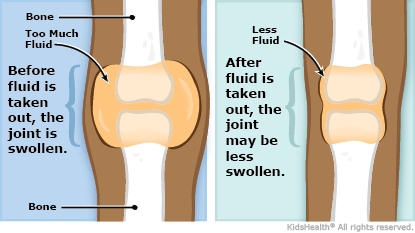Arthrocentesis (Joint Aspiration)
What Is Arthrocentesis?
Arthrocentesis (also called joint aspiration) is a procedure where a doctor uses a needle to take fluid out of a joint. Joints are where two bones meet. They allow our bodies to move. The hips, knees, ankles, elbows, shoulders, and knuckles are all joints.
Why Is Arthrocentesis Done?
Arthrocentesis is done to:
- understand why a joint is swollen or sore
- relieve pain by taking fluid out of a joint

What Happens During Arthrocentesis?
Before Arthrocentesis
First, doctors will make sure that your child is comfortable for the procedure. This means doing some or all of the following:
- Putting a numbing medicine on the skin.
- Using a tiny needle to inject numbing medicine into the area around the joint.
- Sedating your child by giving medicine through an IV (intravenously) to make your child sleepy and relaxed.
If your child is sedated, his or her vital signs (heart rate, blood pressure, temperature, and blood oxygen level) will be checked during the entire procedure.
During Arthrocentesis
When your child is comfortable, the doctor will start the procedure. During arthrocentesis:
- The joint and surrounding area are cleaned with a special soap to sterilize the skin.
- The doctor carefully puts a needle into the joint. Sometimes, an ultrasound is used to guide the needle into the right place.
- When the needle is in place, the doctor uses it to pull some joint fluid into the syringe.
- The needle is taken out and the fluid is sent to a laboratory for testing.
- A small bandage is put over the site where the needle went in.
How Do I Prepare My Child for Arthrocentesis?
If your child is old enough to understand, talk about the procedure:
- Explain what is going to happen during the procedure.
- Explain that it is important to lie still for the test and that a nurse or other health care provider might help hold him or her in place.
- If your child is getting sedation, explain that he or she will sleep through the procedure and probably not remember it.
- Give your child a chance to ask you and the doctor questions.
Ask your doctor if your child can eat or drink before the procedure. If your child will get sedation, he or she may need to avoid eating or drinking for a few hours before the arthrocentesis.
What Happens After Arthrocentesis?
If your child was awake during the procedure, the area where the arthrocentesis was done may hurt a little bit. This should go away within a few hours. If your child was sedated, he or she will need a few hours to rest after the procedure.
Follow your doctor's recommendations for activity after the procedure.
The lab results usually are back in a few days. The lab will look for germs (such as bacteria), germ-fighting cells, signs of inflammation (irritation and swelling), and other things in the joint fluid. Ask your doctor how you will get the test results.
Call your doctor if you have questions, or if your child:
- gets a fever
- has pain that gets worse
- has redness or swelling of the joint
What Are the Risks of Arthrocentesis?
Arthrocentesis is a safe procedure with very few risks. Very rarely, bleeding, infection, or allergic reaction can happen. Your doctor will review all risks with you before your child has the procedure.
How Can I Help My Child?
To make sure your child gets the best care:
- Follow all instructions for caring for the joint where the arthrocentesis was done.
- Be sure to get the test results of the arthrocentesis when they're ready.
- Go to all follow-up visits as recommended by the doctor.


